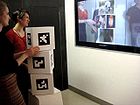CIRCA:Environmental Scan - Current interactive exhibits
From CIRCA
| Line 22: | Line 22: | ||
| - | === | + | ===Getty Museum=== |
| - | + | The AR feature allows users to experience the Augsburg Cabinet via a 3-D object overlay on a live video feed from the viewer’s webcam—in this case, a simulation of the cabinet. The model spins, tilts, and responds as the viewer interacts with it, creating the sense of participation. This experience is caused both by the viewer's presence in the live video along with hand-eye engagement used to control the cabinet's movement. | |
| - | + | To simulate the cabinet, our AR feature at www.getty.edu/collectorscabinet consists of a Web page that displays a 3-D, miniaturized model overlaid on a live video feed from the viewer’s webcam. The user feels a sense of engagement by seeing himself or herself in the live video feed, and by controlling the cabinet’s movement—opening, spinning, and tilting it like its original owner could. | |
Revision as of 00:35, 19 September 2011
Contents |
Environmental Scan
Ontario Science Museum
Visitors to the exhibit can also interact with Papagiannis’s Wonder Turner, an AR experience where viewers physically rotate large cubes to reveal and create a new video composition. The cubes are equipped with black and white AR symbols which the software interprets and emits as video clips. Using the classic ‘exquisite corpse’ format with four interchangeable heads, torsos and feet, rotating the cubes allows the user to create a wild variety of creatures – from a surgeon’s head, belly-dancing torso and penguin feet to a llama head, guitar-playing torso and trampoline feet, and other wondrous creations. An augmented video of the visitor with the transformed turner is simultaneously displayed on the screen.
MOMA NYC
The event illustrates the implications of a technique named "augmented reality": the addition of virtual elements to the real world, viewable using internet-connected and GPS sensitive cameraphones. Augmented reality is chaning our world. In terms of new unlimited visual possibilities, limitless dimensional properties and an unwillingness to comply to (former) physical boundaries and structures, such as a museum wall or context. The 6 floors of the MoMA building were used in a DIY way, and the museum was even extended with a virtual 7th floor.
British Museum
Rooms of the British Museum are augmented. Each of the virtual objects opens a HTTP connection, when tapped and brings visitors to a separate website with additional information.
Getty Museum
The AR feature allows users to experience the Augsburg Cabinet via a 3-D object overlay on a live video feed from the viewer’s webcam—in this case, a simulation of the cabinet. The model spins, tilts, and responds as the viewer interacts with it, creating the sense of participation. This experience is caused both by the viewer's presence in the live video along with hand-eye engagement used to control the cabinet's movement. To simulate the cabinet, our AR feature at www.getty.edu/collectorscabinet consists of a Web page that displays a 3-D, miniaturized model overlaid on a live video feed from the viewer’s webcam. The user feels a sense of engagement by seeing himself or herself in the live video feed, and by controlling the cabinet’s movement—opening, spinning, and tilting it like its original owner could.


